写作中华传统文化之戏曲
描写中华戏曲的作文800字七年级
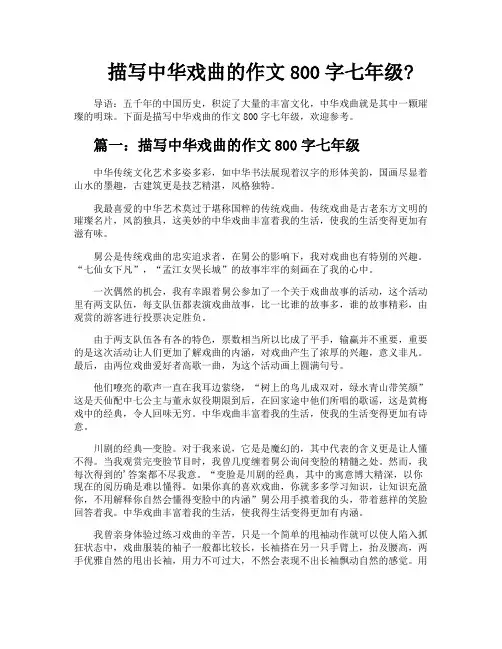
描写中华戏曲的作文800字七年级?导语:五千年的中国历史,积淀了大量的丰富文化,中华戏曲就是其中一颗璀璨的明珠。
下面是描写中华戏曲的作文800字七年级,欢迎参考。
篇一:描写中华戏曲的作文800字七年级中华传统文化艺术多姿多彩,如中华书法展现着汉字的形体美韵,国画尽显着山水的墨趣,古建筑更是技艺精湛,风格独特。
我最喜爱的中华艺术莫过于堪称国粹的传统戏曲。
传统戏曲是古老东方文明的璀璨名片,风韵独具,这美妙的中华戏曲丰富着我的生活,使我的生活变得更加有滋有味。
舅公是传统戏曲的忠实追求者,在舅公的影响下,我对戏曲也有特别的兴趣。
“七仙女下凡”,“孟江女哭长城”的故事牢牢的刻画在了我的心中。
一次偶然的机会,我有幸跟着舅公参加了一个关于戏曲故事的活动,这个活动里有两支队伍,每支队伍都表演戏曲故事,比一比谁的故事多,谁的故事精彩,由观赏的游客进行投票决定胜负。
由于两支队伍各有各的特色,票数相当所以比成了平手,输赢并不重要,重要的是这次活动让人们更加了解戏曲的内涵,对戏曲产生了浓厚的兴趣,意义非凡。
最后,由两位戏曲爱好者高歌一曲,为这个活动画上圆满句号。
他们嘹亮的歌声一直在我耳边萦绕,“树上的鸟儿成双对,绿水青山带笑颜”这是天仙配中七公主与董永奴役期限到后,在回家途中他们所唱的歌谣,这是黄梅戏中的经典,令人回味无穷。
中华戏曲丰富着我的生活,使我的生活变得更加有诗意。
川剧的经典—变脸。
对于我来说,它是是魔幻的,其中代表的含义更是让人懂不得。
当我观赏完变脸节目时,我曾几度缠着舅公询问变脸的精髓之处。
然而,我每次得到的'答案都不尽我意。
“变脸是川剧的经典,其中的寓意博大精深,以你现在的阅历确是难以懂得。
如果你真的喜欢戏曲,你就多多学习知识,让知识充盈你,不用解释你自然会懂得变脸中的内涵”舅公用手摸着我的头,带着慈祥的笑脸回答着我。
中华戏曲丰富着我的生活,使我得生活变得更加有内涵。
我曾亲身体验过练习戏曲的辛苦,只是一个简单的甩袖动作就可以使人陷入抓狂状态中,戏曲服装的袖子一般都比较长,长袖搭在另一只手臂上,抬及腰高,两手优雅自然的甩出长袖,用力不可过大,不然会表现不出长袖飘动自然的感觉。
关于写戏曲的作文5篇
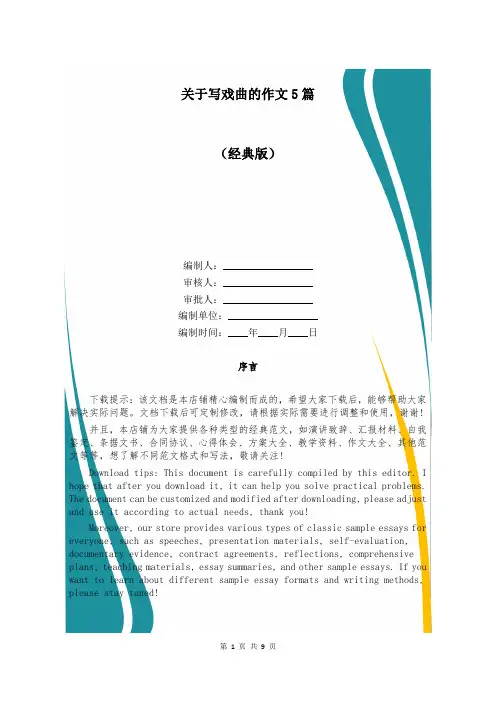
关于写戏曲的作文5篇(经典版)编制人:__________________审核人:__________________审批人:__________________编制单位:__________________编制时间:____年____月____日序言下载提示:该文档是本店铺精心编制而成的,希望大家下载后,能够帮助大家解决实际问题。
文档下载后可定制修改,请根据实际需要进行调整和使用,谢谢!并且,本店铺为大家提供各种类型的经典范文,如演讲致辞、汇报材料、自我鉴定、条据文书、合同协议、心得体会、方案大全、教学资料、作文大全、其他范文等等,想了解不同范文格式和写法,敬请关注!Download tips: This document is carefully compiled by this editor. I hope that after you download it, it can help you solve practical problems. The document can be customized and modified after downloading, please adjust and use it according to actual needs, thank you!Moreover, our store provides various types of classic sample essays for everyone, such as speeches, presentation materials, self-evaluation, documentary evidence, contract agreements, reflections, comprehensive plans, teaching materials, essay summaries, and other sample essays. If you want to learn about different sample essay formats and writing methods, please stay tuned!关于写戏曲的作文5篇优秀的作文是我们语言表达能力和文化素养的充分展示,通过写作文,我们可以整理和归纳自己的思绪,使之更加有条理和清晰,以下是本店铺精心为您推荐的关于写戏曲的作文5篇,供大家参考。
戏曲作文(精选8篇)
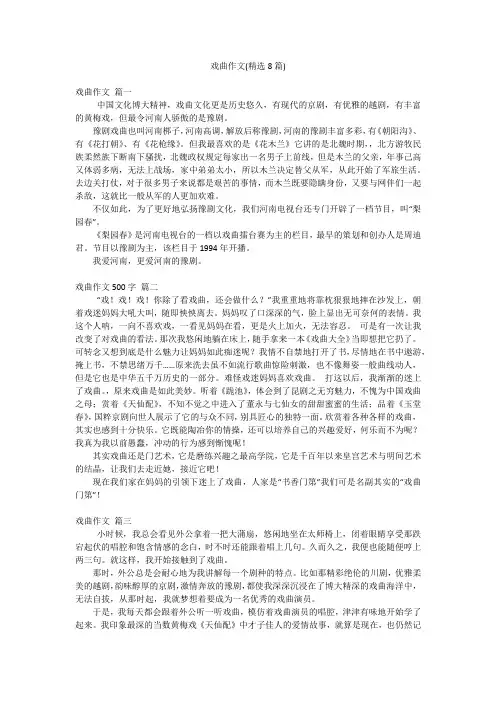
戏曲作文(精选8篇)戏曲作文篇一中国文化博大精神,戏曲文化更是历史悠久,有现代的京剧,有优雅的越剧,有丰富的黄梅戏,但最令河南人骄傲的是豫剧。
豫剧戏曲也叫河南梆子,河南高调,解放后称豫剧,河南的豫剧丰富多彩,有《朝阳沟》、有《花打朝》、有《花枪缘》。
但我最喜欢的是《花木兰》它讲的是北魏时期,,北方游牧民族柔然族下断南下骚扰,北魏政权规定每家出一名男子上前线,但是木兰的父亲,年事己高又体弱多病,无法上战场,家中弟弟太小,所以木兰决定替父从军,从此开始了军旅生活。
去边关打仗,对于很多男子来说都是艰苦的事情,而木兰既要隐瞒身份,又要与网伴们一起杀敌,这就比一般从军的人更加欢难。
不仅如此,为了更好地弘扬豫剧文化,我们河南电视台还专门开辟了一档节目,叫“梨园春”。
《梨园春》是河南电视台的一档以戏曲擂台赛为主的栏目,最早的策划和创办人是周迪君。
节目以豫剧为主,该栏目于1994年开播。
我爱河南,更爱河南的豫剧。
戏曲作文500字篇二“戏!戏!戏!你除了看戏曲,还会做什么?”我重重地将靠枕狠狠地摔在沙发上,朝着戏迷妈妈大吼大叫,随即怏怏离去。
妈妈叹了口深深的气,脸上显出无可奈何的表情。
我这个人呐,一向不喜欢戏,一看见妈妈在看,更是火上加火,无法容忍。
可是有一次让我改变了对戏曲的看法。
那次我悠闲地躺在床上,随手拿来一本《戏曲大全》当即想把它扔了。
可转念又想到底是什么魅力让妈妈如此痴迷呢?我情不自禁地打开了书,尽情地在书中遨游,掩上书,不禁思绪万千……原来洗去虽不如流行歌曲惊险刺激,也不像舞姿一般曲线动人,但是它也是中华五千万历史的一部分。
难怪戏迷妈妈喜欢戏曲。
打这以后,我渐渐的迷上了戏曲。
,原来戏曲是如此美妙。
听着《跪池》,体会到了昆剧之无穷魅力,不愧为中国戏曲之母;赏着《天仙配》,不知不觉之中进入了董永与七仙女的甜甜蜜蜜的生活;品着《玉堂春》,国粹京剧向世人展示了它的与众不同,别具匠心的独特一面。
欣赏着各种各样的戏曲,其实也感到十分快乐。
关于中华传统文化戏曲的作文
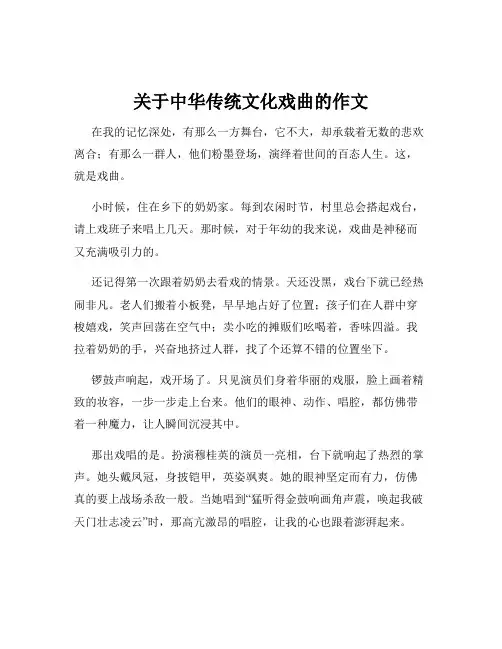
关于中华传统文化戏曲的作文在我的记忆深处,有那么一方舞台,它不大,却承载着无数的悲欢离合;有那么一群人,他们粉墨登场,演绎着世间的百态人生。
这,就是戏曲。
小时候,住在乡下的奶奶家。
每到农闲时节,村里总会搭起戏台,请上戏班子来唱上几天。
那时候,对于年幼的我来说,戏曲是神秘而又充满吸引力的。
还记得第一次跟着奶奶去看戏的情景。
天还没黑,戏台下就已经热闹非凡。
老人们搬着小板凳,早早地占好了位置;孩子们在人群中穿梭嬉戏,笑声回荡在空气中;卖小吃的摊贩们吆喝着,香味四溢。
我拉着奶奶的手,兴奋地挤过人群,找了个还算不错的位置坐下。
锣鼓声响起,戏开场了。
只见演员们身着华丽的戏服,脸上画着精致的妆容,一步一步走上台来。
他们的眼神、动作、唱腔,都仿佛带着一种魔力,让人瞬间沉浸其中。
那出戏唱的是。
扮演穆桂英的演员一亮相,台下就响起了热烈的掌声。
她头戴凤冠,身披铠甲,英姿飒爽。
她的眼神坚定而有力,仿佛真的要上战场杀敌一般。
当她唱到“猛听得金鼓响画角声震,唤起我破天门壮志凌云”时,那高亢激昂的唱腔,让我的心也跟着澎湃起来。
我目不转睛地盯着舞台,看着穆桂英在战场上奋勇杀敌,看着她的智慧和勇气一次次化解危机。
我被她的表演深深吸引,仿佛自己也置身于那个战火纷飞的年代。
演员们的表演太精彩了,每一个动作,每一个表情,都恰到好处。
他们在台上唱念做打,汗水湿透了衣衫,却依然全情投入。
而台下的观众们,也随着剧情的发展,时而欢笑,时而落泪,时而紧张,时而欣慰。
在那一刻,我才真正感受到了戏曲的魅力。
它不仅仅是一种表演形式,更是一种情感的传递,一种文化的传承。
后来,我慢慢长大了,离开了奶奶家,去了城市上学。
城市里的生活丰富多彩,但却很少能再看到戏曲的身影。
偶尔在电视上看到戏曲节目,也总是匆匆换台,觉得那是老一辈人才喜欢的东西。
直到有一次,学校组织了一场戏曲进校园的活动。
当熟悉的锣鼓声再次响起,那些曾经被我遗忘的记忆瞬间涌上心头。
我站在台下,看着演员们精彩的表演,心中涌起一股莫名的感动。
传统文化戏曲的作文
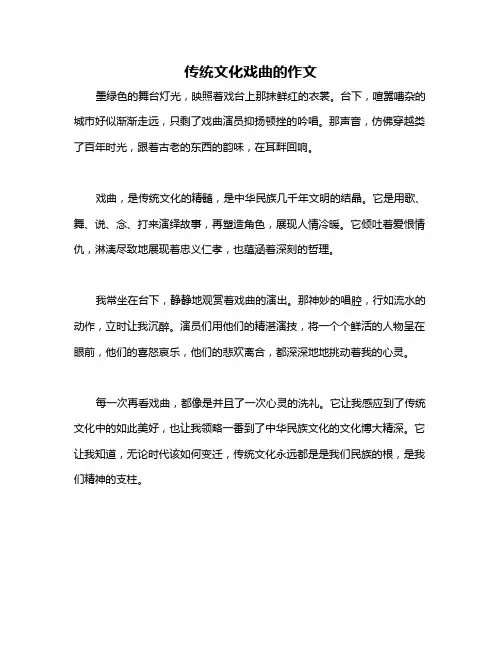
传统文化戏曲的作文
墨绿色的舞台灯光,映照着戏台上那抹鲜红的衣裳。
台下,喧嚣嘈杂的城市好似渐渐走远,只剩了戏曲演员抑扬顿挫的吟唱。
那声音,仿佛穿越类了百年时光,跟着古老的东西的韵味,在耳畔回响。
戏曲,是传统文化的精髓,是中华民族几千年文明的结晶。
它是用歌、舞、说、念、打来演绎故事,再塑造角色,展现人情冷暖。
它倾吐着爱恨情仇,淋漓尽致地展现着忠义仁孝,也蕴涵着深刻的哲理。
我常坐在台下,静静地观赏着戏曲的演出。
那神妙的唱腔,行如流水的动作,立时让我沉醉。
演员们用他们的精湛演技,将一个个鲜活的人物呈在眼前,他们的喜怒哀乐,他们的悲欢离合,都深深地地挑动着我的心灵。
每一次再看戏曲,都像是并且了一次心灵的洗礼。
它让我感应到了传统文化中的如此美好,也让我领略一番到了中华民族文化的文化博大精深。
它让我知道,无论时代该如何变迁,传统文化永远都是是我们民族的根,是我们精神的支柱。
我爱戏曲,爱它那古老的记忆的魅力,爱它那深厚的内涵,更爱它承载着的那份中华民族的文化自信。
我希望,更多的人能穿过大厅戏院,感受戏曲的魅力,圣物这足够地的文化遗产。
台上的演员,依旧在倾情表演,他们用自己的,将传统文化的精髓传达消息给每一个观众。
我从不怀疑,如果能我们无比热爱,戏曲这朵文化之花,一定都能够永远永远绽放开来。
戏曲的作文(优秀8篇)
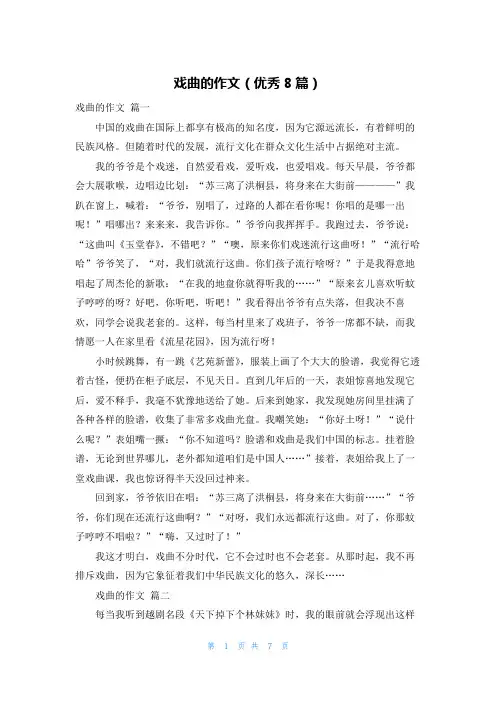
戏曲的作文(优秀8篇)戏曲的作文篇一中国的戏曲在国际上都享有极高的知名度,因为它源远流长,有着鲜明的民族风格。
但随着时代的发展,流行文化在群众文化生活中占据绝对主流。
我的爷爷是个戏迷,自然爱看戏,爱听戏,也爱唱戏。
每天早晨,爷爷都会大展歌喉,边唱边比划:“苏三离了洪桐县,将身来在大街前————”我趴在窗上,喊着:“爷爷,别唱了,过路的人都在看你呢!你唱的是哪一出呢!”唱哪出?来来来,我告诉你。
”爷爷向我挥挥手。
我跑过去,爷爷说:“这曲叫《玉堂春》,不错吧?”“噢,原来你们戏迷流行这曲呀!”“流行哈哈”爷爷笑了,“对,我们就流行这曲。
你们孩子流行啥呀?”于是我得意地唱起了周杰伦的新歌:“在我的地盘你就得听我的……”“原来玄儿喜欢听蚊子哼哼的呀?好吧,你听吧,听吧!”我看得出爷爷有点失落,但我决不喜欢,同学会说我老套的。
这样,每当村里来了戏班子,爷爷一席都不缺,而我情愿一人在家里看《流星花园》,因为流行呀!小时候跳舞,有一跳《艺苑新蕾》,服装上画了个大大的脸谱,我觉得它透着古怪,便扔在柜子底层,不见天日。
直到几年后的一天,表姐惊喜地发现它后,爱不释手,我毫不犹豫地送给了她。
后来到她家,我发现她房间里挂满了各种各样的脸谱,收集了非常多戏曲光盘。
我嘲笑她:“你好土呀!”“说什么呢?”表姐嘴一撅:“你不知道吗?脸谱和戏曲是我们中国的标志。
挂着脸谱,无论到世界哪儿,老外都知道咱们是中国人……”接着,表姐给我上了一堂戏曲课,我也惊讶得半天没回过神来。
回到家,爷爷依旧在唱:“苏三离了洪桐县,将身来在大街前……”“爷爷,你们现在还流行这曲啊?”“对呀,我们永远都流行这曲。
对了,你那蚊子哼哼不唱啦?”“嗨,又过时了!”我这才明白,戏曲不分时代,它不会过时也不会老套。
从那时起,我不再排斥戏曲,因为它象征着我们中华民族文化的悠久,深长……戏曲的作文篇二每当我听到越剧名段《天下掉下个林妹妹》时,我的眼前就会浮现出这样一幅画面:莺歌燕舞,鸟语花香,树木从生,百花争艳,清澈见底的潺潺流水,雍容华美的亭台楼阁。
中国传统戏曲作文600字
中国传统戏曲作文600字中国传统戏曲作文600字中国传统戏曲的形成,最早可以追溯秦汉时代。
但形成过程相当漫长,到了宋元之际才得成型。
成熟的戏曲要从元杂剧算起,经历明、清的不断发展成熟而进入现代,历八百多年繁盛不败,如今有360多个剧种。
今天小编就来分享中国传统戏曲600字,请各位读者好好欣赏和借鉴。
中国传统戏曲作文600字(一)中国的戏曲,源远流长,有着鲜明的民族风格,每个剧种,都有着它独特的魅力、韵味以及内涵:如京剧的雍容华美,昆剧的典雅精致,梆子戏的高亢悲凉,还有越剧的轻柔婉转……可这些中华民族的瑰宝,在现在这个多元化的社会中,似乎有些站不住脚根。
如今的艺术形式日渐丰富了,传统戏曲面临着更严峻的考验、挑战。
它渐渐地被人们淡忘了,取而代之的是“流行”,更多人喜欢追流行,认为在流行中能够展现西我,获得满足。
“弃之戏曲,投之流行”。
为什么传统戏曲会面临如此的抉择?是它乏味?不是。
是因为它抵制不住流行的强撼冲击。
流行是什么?引领潮流,追求时尚。
不可否认,“流行”,也是一门艺术,但是现实中的艺术。
打个比喻,流行就像划过天际的一颗流行,一划而过,短暂却璀璨,更多人惊艳于它的闪亮,于是抛传统追流行,心中只觉得流行放射出的夺目光彩才为自己瞩目。
殊不知,一划而过的背后,是寂静,没有任何追求后的精神享受。
而传统戏曲,就好像宇宙中一颗并不耀眼夺目的恒星,虽然若隐若现,但它始终保持自己的韵律哼唱宁静。
它摆脱了喧嚣与浮华。
深夜,一个人静静地坐着,闭目养神地听一段戏曲,或是泡上一杯醇香的茶,看一会儿戏剧节目,你定会感到超脱的自然与静心,感觉古老却清新的戏曲很美,很美。
这就是戏曲的魅力,如一袭清风吹拂着,精神与灵魂,此刻,都能得到升华。
其实,中国传统戏曲,根本不存在什么“去”与“留”,它一直是我么民族的瑰宝,是东方的歌剧,是永恒的历史文化。
听,风的拂动,叶的摆动,云的笑声,是我自失地又想到了古老而自然的韵律。
中国传统戏曲作文600字(二)戏曲源远流长,是我国的经典,不同地方的戏曲有不同的风格和特色,它让人赏心悦目,其情节有的催人泪下,有的振奋人心,多姿多彩,出神入化。
中国传统文化戏曲作文
中国传统文化戏曲作文中国传统文化戏曲作文(精选45篇)中国传统文化戏曲作文篇1古典舞一般都是在民间舞的基础上,经过历代舞蹈家的提炼、加工和创造而逐渐形成的舞蹈。
因此,古典舞都有一整套规范化、程式化的表演动作及技巧,有其独特的表演风格。
中国古典舞起源于古代封建社会。
自宋代后,中国的歌、舞、剧相结合的戏曲艺术兴起。
后来,古典舞逐渐被戏曲所吸收、融合,至今大多保存在中国戏曲艺术里,从中大致可以看出它的风格、特点。
中国古典舞在表演动作上有着自己独特的规律和法则,讲究外在的手、眼、身、法、步与内在意、劲、精、气、神的合一,手一指、目一视、足一抬都要与整个身体协调。
注重身韵、气韵、音韵、神韵的整体韵律性和俯仰、屈伸、开合、顿挫的鲜明节奏感,以及刚柔相济、动静相宜、物我一体、身心合一的美学追求。
同时,动作从运动到静止都离不开“曲”和“圆”,即遵守欲进先退,欲伸先屈,欲起先伏,欲高先低,欲直先迂的原则。
比如,手要向左指,行就要先往右略略运一下,然后再转向左方。
动作线条必圆浑完整,如做一个“云手”动作,要像天上的云彩变幻那样,随风流动,轻盈美观。
中国古典舞在表现手法上讲究集中、洗练、夸张、虚拟。
虚拟是没有实物的表演,比如,一个人只拿一根马鞭,就能一会儿表现战马飞奔,四蹄腾空;一会儿表现信马由缰,缓缓而行。
手握一柄船桨,不仅要表现出是在行船,而且还要表现出是逆水上行还是顺水而下。
虚拟把生活中有特征性、代表性的动作夸张地表现出来,从而引起观众的艺术想象和生活联想。
只要两三个人就可代表着千军万马,只在舞台上走五六步就可以表示越过万水千山,这就是中国古典舞独特的艺术表现手法。
中国传统文化戏曲作文篇2中国的戏曲文化源远流长,在老一辈人的眼里,听戏是他们最高的享受,在悠久的岁月中,戏曲在逐渐的演变,也在不停地拓宽视野以及创造新的种类。
然而,随着现代电子时代的到来,流行音乐似乎成了人们的首选,戏曲作为中国的非物质文化遗产,渐渐地走出了我们的视野。
传统文化戏曲的作文
传统文化戏曲的作文
传统戏曲的魅力。
在梨园子里,戏曲唱得那叫一个热闹啊!那戏服,五颜六色的,简直跟画儿里走出来的一样。
演员们动作麻利,眼神里都是戏,看
得人心里直痒痒。
说起《牡丹亭》,那可真是爱情戏里的经典。
杜丽娘和柳梦梅,两个人爱得死去活来,看得我都忍不住掉眼泪。
那声音,柔美又动听,仿佛能让人穿越时空,回到古代。
《霸王别姬》可是个悲壮的戏。
项羽和虞姬,一个英雄一个美人,最后却落得个离别的下场。
那唱腔,高亢又悲凉,听得人心都
碎了。
舞台上光影交错,仿佛真的看到了战场上的硝烟。
《长生殿》啊,那就是个仙境般的戏。
唐玄宗和杨贵妃的爱情,简直美得让人心醉。
演员们的表演,就像是在画里走出来的一样,
美得让人移不开眼。
那节拍,轻快又悠扬,让人仿佛置身于仙境之中。
戏曲这东西,真是文化的瑰宝。
它不仅仅是个表演,更是咱们中华民族的历史和情感。
每次看戏曲,都能感受到那种深厚的文化底蕴和情感共鸣。
不得不说,传统戏曲,真的是魅力无穷啊!。
戏曲作文600字作文8篇
戏曲作文600字作文8篇(经典版)编制人:__________________审核人:__________________审批人:__________________编制单位:__________________编制时间:____年____月____日序言下载提示:该文档是本店铺精心编制而成的,希望大家下载后,能够帮助大家解决实际问题。
文档下载后可定制修改,请根据实际需要进行调整和使用,谢谢!并且,本店铺为大家提供各种类型的经典范文,如述职报告、调研报告、策划方案、活动方案、心得体会、应急预案、规章制度、教学资料、作文大全、其他范文等等,想了解不同范文格式和写法,敬请关注!Download tips: This document is carefully compiled by this editor. I hope that after you download it, it can help you solve practical problems. The document can be customized and modified after downloading, please adjust and use it according to actual needs, thank you!Moreover, our store provides various types of classic sample essays, such as job reports, research reports, planning plans, activity plans, personal experiences, emergency plans, rules and regulations, teaching materials, complete essays, and other sample essays. If you want to learn about different sample formats and writing methods, please pay attention!戏曲作文600字作文8篇审题是确保作文观点明确和有力的关键,只有明确题目要求,我们才能写出有说服力的作文,无论是在学习中还是工作中,作文都是我们必须掌握的基本技能,下面是本店铺为您分享的戏曲作文600字作文8篇,感谢您的参阅。
- 1、下载文档前请自行甄别文档内容的完整性,平台不提供额外的编辑、内容补充、找答案等附加服务。
- 2、"仅部分预览"的文档,不可在线预览部分如存在完整性等问题,可反馈申请退款(可完整预览的文档不适用该条件!)。
- 3、如文档侵犯您的权益,请联系客服反馈,我们会尽快为您处理(人工客服工作时间:9:00-18:30)。
一、(2012年天津卷)假设你是李津,你的美国朋友Chris就读于天津某国际学校。
他熟悉中国文化,特别是戏曲文化。
8月5日下午2:00在新落成的天津大剧院将上演越剧《梁山伯与祝英台》。
请你根据以下提示,用英语给Chris写一封电子邮件,邀请他一起观看演出。
☞提出邀请并简述原因;☞提出观剧后活动建议(如参观附近的博物馆或美术馆等);☞请求对方回复。
注意:1. 请使用规范英语,词数不少于100;2. 可适当加入细节,以使内容充实、行文连贯;3. 开头和结尾已给出,不计入总词数。
参考词汇:越剧Shaoxing Opera 《梁山伯与祝英台》Butterfly Lovers天津大剧院Tianjin Grand TheaterDear Chris,I have good news to tell you._______________________________________________________________________________ _______________________________________________________________________________ _______________________________Yours,Li Jin【参考范文】Western people cry for Romeo and Juliet while the Chinese weep over Liang Shanbo and Zhu Yingtai.Popular in the southern region near the Yangtze River, the Shaoxing opera originated a century ago around Shengxian county, Zhejiang province. Because it belonged to the Yue Stage in ancient times, it was also called Yueju Opera. Derived from a kind of story-telling, Yueju Opera is noted for its lyricism and sweet tunes that give the performances local color.One of the most popular repertoires of the Yueju Opera, Butterfly Lovers is a story that begins when Zhu Yingtai, a woman disguised as man, goes to Hangzhou to study. On the way, she meets Liang Shanbo and they become sworn "brothers".When they have to part after three years in school, Zhu hints that she is a woman, but Liang does not understand. Later, when Liang learns the truth, he hurries to Zhu's family to make an offer of marriage, but finds Zhu's father has married her to the son of the county magistrate.With grief and indignation, Liang dies of illness. As Zhu stands crying in front of Liang's tomb,it opens, and Zhu jumps into it - and the two lovers turn into butterflies.二、留言条:邀请观看京剧表演假定你是李华,你想邀请在中国留学的英国好友Peter观看京剧表演,但Peter不在家,你给他写张留言条,包括以下内容:1、你到Peter家的目的;2、介绍京剧;3、询问什么时候方便,再约时间观看。
注意:1、词数100左右;2、可以适当增加细节,以使行文连贯。
参考词汇:quintessence精华,精粹;ornate华丽的【参考范文】Dear Peter,I came to see you but you were out. I’d liketo invite you to see Beijing Opera with me next week, since you have always wanted to know more about Chinese culture since the first day to China.With a history of nearly 200 years, Beijing Opera is a form of traditional Chinese theatre, which is considered as the quintessence of Chinese culture. The performers in ornate costume perform various stories happened in history to audience by singing, dance and motions. I can tell you more about it when we meet.Please let me know when you will be free and I will buy the tickets in advance. I sincerely hope that you can accept my invitation and I’m sure you’ll enjoy it.Yours,Li HuaTraditional Chinese opera (Chinese: 戲曲; pinyin: xìqǔ; Jyutping: hei3 kuk1), or Xiqu, is a popular form of drama and musical theatre in China with roots going back to the early periods in China. It is a composite performance art that is an amalgamation of various art forms that existed in ancient China, and evolved gradually over more than a thousand years, reaching its mature form in the 13th century during the Song Dynasty. Early forms of Chinese theater are simple, but over time they incorporated various art forms, such as music, song and dance, martial arts, acrobatics, as well as literary art forms to become traditional Chinese opera.There are numerous regional branches of traditional Chinese opera, including the Beijing opera, Shaoxing opera, Cantonese opera and kunqu and Lvju.附:Chinese Opera 戏曲In his ‘Civilization of China’(1911) Herbert Giles wrote “For pleasure pure and simple, independent of gains and losses, the theater occupies the warmest place in every Chinaman's heart.”. It was for centuries the top form of entertainment in China. It also goes by the name 国粹guócuìmeaning Quintessence of the nation.Chinese Opera is an art-form that includes many elements: music; dance; acting; mime; comedy; tragedy; acrobatics and martial arts. An aspiring opera performer has to learn to 唱念做打chàng niàn zuòdǎsing, talk, act and fight. Over the centuries the art form has become more refined, as in much of Chinese art, the aim is to emulate former masterpieces rather than innovate. There are strict rules and conventions that limit creativity and yet each generation seeks to surpass what has gone before.Operas are divided between Wenxi (civilian plays) and Wuxi (military dramas) and between dramas; comedies and farces. The story-lines come from folk tales, legends and classical literature - anything too contemporary was considered politically dangerous. It was forbidden to portray emperors or empresses of the current dynasty.The art was admired by European visitors, J.D. Vaughan wrote in the Penang Gazette in 1853 “...The scenes that followed I think you will allow deserve to be classed among our best farces.The characters are well sustained and the part of the young huntsman Ma Guan, well played...”.China National Peking Opera Company performing the Red Haired Galloping Horse opera at Meilanfang theatre in Beijing, China Copyright © Dreamstime see image licenseHistoryThere is evidence for opera as far back over a thousand years when Emperor Xuanzong created a troupe to perform in his ‘Pear Garden’, to this day opera performers are colloquially known as ‘Followers of the Pear Garden’. The province of Shanxi was the initial center for this new art-form. The opera was further developed in the Song dynasty and taken up during the Mongol dynasty with hundreds of local forms competing for audiences. During the Mongol dynasty the opera became more regimented with the Imperial form consisting of four acts, each with a different main actor.In the Ming dynasty, Kunqu Opera 昆曲kūn qǔoriginating from Suzhou, Jiangsu became the most important form; characteristically the bamboo flute is used as a melodious accompaniment in these operas. Some of the best loved works were written for Kunqu Opera in this period including “The Peony Pavilion”, “The Peach Blossom Fan”, “Romance of the Three Kingdoms”, and “Journey to the West”involving the impish antics of the monkey king.At the same time more roles were created including 丑Chǒu (a sort of clown using the Chinese character that means 'ugly') and a 净Jìng a striking, aggressive role. The Chou would often introduce earthy humor into the opera.The opera is somewhat similar to the state of European theater in the pre-Elizabethan era, as, for example the boys played the female parts and the sets were very bare. However unlike Europe, the Chinese form changed little in the following centuries. The repertoire was not enlivened by new stories and the lowly status of actors continued. For example, actors and their children were not permitted to enter the Imperial examinations and remained a class apart.There are a variety of forms in different regions of China through the ages but they broadly follow similar lines.China National Peking Opera Company performing the Red Haired Galloping Horse opera at Meilanfang theatre in Beijing Copyright © Dreamstime see image licensePeking Opera 京剧jīngjùQing Emperor Qianlong is credited with developing Bejing (Peking) Opera from the Kunqu and other forms he saw in Anhui and Hubei provinces. It merges singing, acrobatics, mime, dance and dialogue into a single art form. Dowager Empress Cixi was a great fan and patron of all the great actors of the day. As many as 10,000 operas were written at the peak of its popularity. It remains the main form of Chinese opera.Originally there were just four character roles, 老生lǎoshēng (elderly man) who played emperors; general and servants; 武生wǔshēng for military heroes. A wusheng needs to be a good acrobat as well as a good singer. 青衣qīng yīis the leading lady part often a high-born maiden or a simple country girl. 花旦huādàn (dan) is often a courtesan or slave girl. 小生xiǎoshēng is the juvenile male role but never the main lead.The female roles were played by young men as it was considered indecent for men and women to work together as actors. Qing Emperor Qianlong explicitly forbade female actors for his new Beijing operas. The ‘women’talk with a high pitched sing-song voice and sing in falsetto. Nowadays though women are played by women.The make-up is put on thickly over much of the face in standard designs and color schemes with well understood conventions. White make-up is used to clearly identify the villain; black for kind but forceful characters. Generals and warriors have bright red and yellow make-up as red indicates loyalty and courage; purple solemnity and fairness; green for wild and impulsive; blue for fierce and far-seeing characters. Generally the good characters have simple, smooth patterns of make-up while the evil ones have complex designs. The costume and make-up are all that is needed to identify a character.Chinese Musical AccompanimentMusical accompaniment is provided by a band of musicians often in plain view to the right hand side of the stage. Traditional instruments are used with heavy use of percussion. Chinese people use the phrase to go to ‘listen to the Opera’rather than ‘watch the Opera’. Connoisseurs may sit with their eyes closed to fully appreciate the music and singing; it is considered an essential part of the performance. Typically there will be about ten musicians playing a range of instruments: the erhu and huqin (stringed instruments); sheng (mouth organ); pipa (lute); suona(trumpet); gongs; wooden blocks and drums.VarietiesNorthernBeijing opera (Peking Opera) (京剧)Yu opera (豫剧)Errenzhuan/Bangzixi/Benbeng opera (二人转) (Northeast China) Hebei bangzi (河北梆子) (Hebei)Jiju (吉剧) (Jilin)Lüju (吕剧) (Shandong)Maoqiang (茂腔) (Shandong)Pingju (评剧) (Hebei)Puju (蒲剧) (Shanxi)Qinqiang (秦腔) (Shaanxi)Zaju (雜劇)Jinju (晋剧) (Shanxi)SouthernCantonese opera (Guangdong)Gaojia opera (Quanzhou)Huaguxi (花鼓戏) (Hubei/Hunan)Huangmei opera (Anhui)Shanghai opera (Shanghai)KunquLiyuan operaTeochew operaHakka opera (汉剧)Min opera (Fuzhou)Puxian opera (Putian, 莆仙戏) Nanxi (Wenzhou)Ouju (Wenzhou)Shaoxing opera/Yueju (Zhejiang) Taiwanese operaWuju (Jinhua)Sichuan opera (S。
